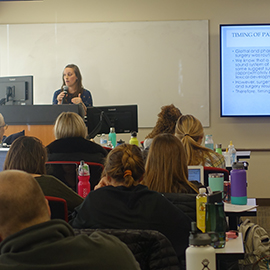 According to the Centers for Disease Control (CDC), more than 2,600 babies are born with a cleft palate and more than 4,400 babies are born with a cleft lip with or without a cleft palate each year, making it one of the most common birth defects in the United States.
According to the Centers for Disease Control (CDC), more than 2,600 babies are born with a cleft palate and more than 4,400 babies are born with a cleft lip with or without a cleft palate each year, making it one of the most common birth defects in the United States.
As a result, the University’s Speech-Language Pathology students recently had the opportunity to learn more about servicing babies, children and adults who have these defects. Specialists from the Cleft Palate and Craniofacial Program at Cooper University Hospital in New Jersey – including an interdisciplinary team of three speech-language pathologists, an audiologist, a plastic surgeon and an orthodontist – provided a two-day course on how to meet the multifaceted needs of this specific population.
Cleft lips and cleft palates form during the fourth and seventh week of pregnancy. A cleft lip occurs if the tissue that makes up the lip does not join completely before birth resulting in an opening in the upper lip. Children with a cleft lip can also have a cleft palate, which happens when the tissue that makes up the roof of the mouth does not join together completely during pregnancy. The causes of orofacial clefts, the common name for both cleft lip and cleft palate together, among most infants are unknown according to the CDC, but some factors which may increase the likelihood of a baby developing either one or both of these defects include:
“We were fortunate to have the Cleft Palate and Craniofacial team from Cooper lead us through an overview of the care of children with clefts of the lip and palate,” said Patricia Martin Mayro, MA, CCC-SLP, clinical instructor in the Speech-Language Institute.
Babies and children with a cleft lip with or without a cleft palate face a variety of challenges – depending on the type and severity of the cleft – which is the reason why an interdisciplinary team works effectively. Those affected can often have difficulty feeding, ear infections and hearing loss, dental problems, speech difficulties, and coping challenges. Surgery is generally recommended to repair a cleft lip within the first few months of the baby’s life and before they turn one-year-old whereas surgery for a cleft palate is recommended within the first 18 months of life or earlier if possible. To be all encompassing, the course included topics such as feeding a baby with a cleft and or craniofacial condition, dealing with speech issues from birth to two-years of life, evaluation and management of hearing and middle ear issues, speech intervention, genetics, basic anatomy and the surgeon’s role in treating craniofacial and cleft conditions and orthodontics during the treatment period.